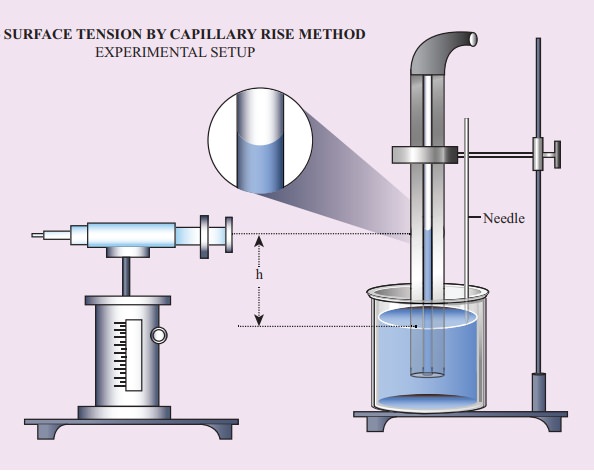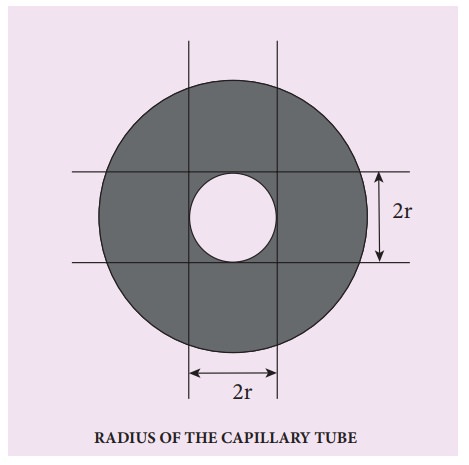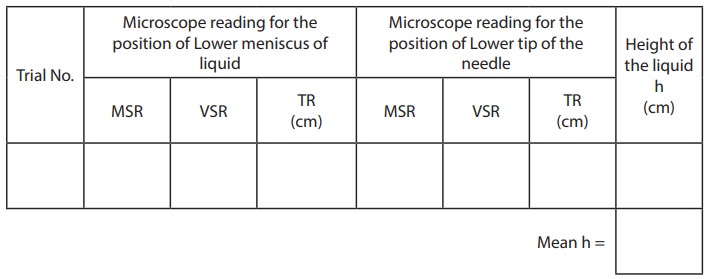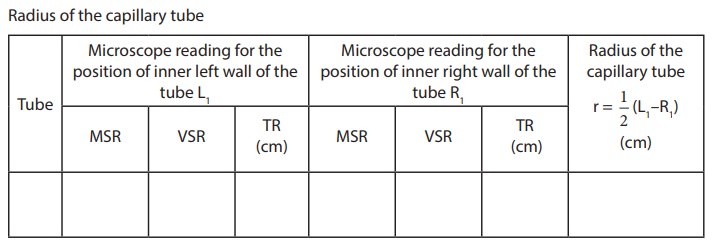Physics Laboratory Practical Experiment - Surface Tension By Capillary Rise Method | 11th Physics : Practical Experiment
Chapter: 11th Physics : Practical Experiment
Surface Tension By Capillary Rise Method
SURFACE TENSION BY CAPILLARY RISE
METHOD
AIM
To
determine surface tension of a liquid by capillary rise method.
APPARATUS REQUIRED
A beaker
of Water, capillary tube, vernier microscope, two holed rubber stopper, a
knitting needle, a short rubber tubing and retort clamp.
FORMULA
The
surface tension of the liquid T = hrŽāg/2
N m-1
whereŌĆā
T ŌåÆ Surface tension of the liquid (N mŌĆō1)
h ŌåÆ height
of the liquid in the capillary tube (m)
r ŌåÆ radius
of the capillary tube (m)
Žā ŌåÆ
Density of water (kg mŌĆō3)
(Žā = 1000 kg mŌĆō3)
g ŌåÆ
Acceleration due to gravity (g = 9.8 m sŌĆō2)
DIAGRAM

PROCEDURE
┬Ę
A clean
and dry capillary tube is taken and fixed in a stand
┬Ę A beaker containing water is placed on an adjustable platform and the capillary tube is dipped inside the beaker so that a little amount of water is raised inside.
┬Ę Fix a needle near the capillary tube so that the needle touches the
water surface
┬Ę
A Vernier
microscope is focused at the water meniscus level and the corresponding reading
is taken after making the cross wire coincidence.
┬Ę
Vernier
microscope is focused to the tip of the needle and again reading is taken and
noted.
┬Ę
The
difference between the two readings of the vertical scale gives the height (h)
of the liquid raised in the tube.
┬Ę
Now to
find the radius of the tube, lower the height of the support base and remove
the beaker, carefully rotate the capillary tube so that the immersed lower end
face towards you.
┬Ę
Focus the
tube using Vernier microscope to clearly see the inner walls of the tube.
┬Ę
Let the
vertical cross wire coincide with the left side inner walls of the tube. Note
down the reading (L1)
┬Ę
Turn the
microscope screws in horizontal direction to view the right side inner wall of
the tube. Note the reading (R1). Thus the radius of the tube can be
calculated as ┬Į(L1-R1).
┬Ę
Finally
calculate the surface tension using the given formula.

OBSERVATIONS
To measure
height of the liquid (h)
Least
count of the microscope = ________ ├Ś 0.001cm

Radius of
the capillary tube

CALCULATION
Mean rise
of the liquid in the capillary tube h = _________ cm
= _________ m
Diameter
of the capillary tube 2r = _________ cm
Radius of
the capillary tube r = _________ m
Density of
the liquid Žā = 1000 kg m-3
Acceleration
due to gravity g = 9.8 mŌĆås-2
Surface
tension T = hrŽāg/2
=
____________Nm-1
RESULT
Surface
tension of the given liquid by capillary rise method T =________N mŌĆō1
Related Topics